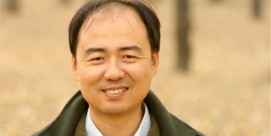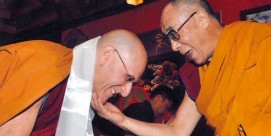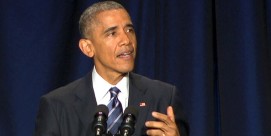In This Episode << SLIDE LEFT TO SEE ADDITIONAL SEGMENTS
China, Tibet, and Buddhist Ethics: An Overview
by Christopher Queen
Buddhist teachings do not rule out the use of force to relieve a greater suffering, although the Buddhist tradition is rightly known for the systematic practice of nonviolence, its first ethical precept.
A concise summary of the texts authorizing the use of force may be found in Peter Harvey’s An Introduction to Buddhist Ethics, where most examples are of killing a tyrant who is terrorizing the masses. Even here, however, the paradigm is of the Buddha, who famously stopped a serial killer in his tracks by the force of his goodness and then accepted the criminal (known as Angulimala for his signature “necklace of fingers”) into the monastic order.
The Tibetans are historically a bellicose people who have defended themselves with force throughout history. Monks have taken to the streets before, even in the 20th century. What follow is a summary of the Tibetan conflict with the Chinese in modern history.
The struggle for Tibet is perhaps the best known theater of engaged Buddhism in the early 21st century, due in part to the global activism of Tenzin Gyatso, the 14th Dalai Lama, and the strong interest of the press and the public since 1959, when Chinese troops overran the country. Certainly the political, economic, cultural, and environmental carnage that resulted from Chinese annexation of the Tibetan region has been well documented (see recommended reading list).
Political instability is not new to Tibet, but it is arguably its defining characteristic since before the transmission of Buddhism to the region in the 7th century CE. Its provinces were not unified until the 17th century, when the first Dalai Lama consolidated the country under Manchu patronage. When the British invaded in 1904, the 13th Dalai Lama fled to Mongolia and attempted unsuccessfully to enlist Russian support. The Chinese recovered control of the country in 1909, but were expelled by the Dalai Lama in 1913.
Declaring independence in 1914, the 13th Dalai Lama attempted to institute political reforms but was opposed by the monasteries. After an uprising of monks in 1921, the Dalai Lama gave up all efforts to modernize the country; the army was disbanded, English schools closed, and regents took over the country following the Dalai Lama’s death in 1933. In 1947, armed monks of the Sera Je monastery took part in a rebellion that resulted in 300 deaths. Elements of the sangha (Buddhist clergy) called on China to liberate the country. The People’s Liberation Army entered the Tibetan capital, Lhasa, in 1951 and brokered a 12-point accord between Beijing and Lhasa. But in 1959 another uprising of monks triggered a crackdown that has placed the country firmly under Chinese control ever since. The 14th Dalai Lama, still a teenager, fled to India with the senior members of the government.
In 1966, the Chinese Cultural Revolution encompassed Tibet in the systematic destruction of all things Buddhist: clergy, monasteries, libraries, rituals, and artifacts. The Free Tibet Movement emerged in the Tibetan refugee camps in India in the 1970s, with the Tibetan Youth Congress and the Tibetan People’s Freedom Movement giving voice to the growing militancy of the exiles. In 1977, a group of young Tibetans held a hunger strike outside the United Nations Information Center in New Delhi, stating to the press, “We Tibetans are treated as political lepers by the international community and our cause as an embarrassing and contagious disease. We the victims are ignored and shunned while our oppressors are courted and feted by a world gone mad. We are peaceful people and we have nowhere to turn to for justice except the United Nations.”
In the three decades that followed, while unrest has simmered within the refugee communities in India and the West, the Dalai Lama has increasingly become an international icon of nonviolent resistance. His tools have been the lecture circuit and the printing press, not the streets that Mahatma Gandhi and Martin Luther King Jr. used to such advantage in the struggle for independence in India and civil rights in the United States. The Dalai Lama’s consistent rejection of military means is based on Buddhist principles, as is his deep conviction that political reform must be built on the interdependence of human goals and “a policy of kindness,” as he explained in his evening address to the Nobel Committee upon receiving the Peace Prize in 1989: “It is quite clear that everyone needs peace of mind. The question, then, is how to achieve it. Through anger we cannot; through kindness, through love, through compassion we can achieve one individual’s peace of mind. The result of this is a peaceful family….Extended to the national level, this attitude can bring unity, harmony, and cooperation with genuine motivation. On the international level, we need mutual trust, mutual respect, frank and friendly discussion with sincere motivation, and joint efforts to solve world problems. All these are possible. But first we must change within ourselves.”
Such a “ripple effect” of spiritual practice on social and political reality — His Holiness frequently describes to Western audiences how he rises at 4 a.m. each day to generate kindness toward the Chinese, “who are also subject to suffering, as the Buddha taught” — is recognized as a traditional principle in Buddhist social ethics and has become a touchstone for engaged Buddhists today. The slogan “Inner Peace, World Peace” has motivated individuals and organizations to enter the political arena on behalf of the Tibetan cause and many others.
Christopher Queen is a lecturer on the study of religion at Harvard University and president of the Barre Center for Buddhist Studies in Barre, Massachusetts.







